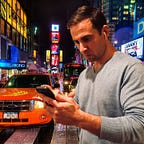The age of personalized instructional content has arrived
Years ago when I was a pre-service teacher, I had the privilege of working with an amazing mentor. She was a master at the “hook”. Getting students to buy into each lesson with an attention grabbing skit, homemade video or activity.
She was also way ahead of her time with technology. The way that she used homemade video in her course has inspired me to this day to do more to personalize the content that I create and use in my courses. One lesson stood out to me above all others. My mentor was a bit of a world traveler and created travel vlogs using a VHS recorder. What is most significant about this is that her work predated Youtube and the term vlog by well more than a decade.
One such travel vlog that she used for instruction was from her trip to the former Soviet Union. It was filmed in the very early 1990's, shortly after the fall of the Berlin Wall. The footage included her son Gary. I mention his name only because we share this wonderful, and relatively uncommon name. Scenes included the two visiting parts of Moscow that Americans were not welcome in for decades. The way this video built context and personalized the experience of learning about the Soviet Union was unlike anything I had ever experienced. It was an immersive experience.
My mentor did this with far fewer tools then we have now. I doubt that she was even borrowing ideas from someone else’s work. It was personal and organic. It was storytelling at its best.
The YouTube Era
In 2006 YouTube was launched and the landscape of video creation and sharing has been forever changed. People are experiencing the same kind of immersive viewing experience that I experienced in my mentors classroom routinely. Because of this we (educators) need to build dynamic interactive content in order to compete for our learners’ attention. This means that the content is not only accessible by learners anytime, anywhere, but it also means that the content has to be captivating. The best way to achieve this is to have your content reflect you… the creator.
The mark of “personalization” is what truly sets apart 21st century content from 20th century content. Content from the 20th century was prepackaged by necessity. Tools for creating, sharing and curating were just not developed enough. That’s why textbooks and standardized tests became prevalent. Thank goodness that era is gone now!
Social-emotional learning is critical
When we create digital age instructional materials it’s important to prioritize social-emotional learning. That means our content should help students in acquiring and applying attitudes and skills necessary for managing their emotions and relationships. This includes helping students to establish goals and develop empathy and positivity. We cannot do this when we consistently rely on materials made by others.
The only way that we can balance the academic and social-emotional needs of our learners is to be creators of content ourselves. By doing this we act as role models in shaping learners as digital citizens.
What kinds of tools can we use to create quality content that has both social-emotional and academic integrity?
The good news is that the tools that we have access to are more bountiful and diverse than ever before. You can choose to find a niche that best reflects your tastes and interests. For instance, you may be a gamer. Well then, create games if that’s what you fancy. Maybe you love fiction. Then create your own works of fiction. At the touch of screen we can create anything and everything. No excuses.
Here’s some examples of tools that we can use to create personalized 21st century content with:
- Books: eBook creator
- Video: Adobe Spark
- eMagazines: Flipboard
- Virtual Reality: Be There VR
These tools are a small sampling of some of my personal favorites. They make it easy to create professional content. They remove the barriers to create amazing content that have always stood in our way. Another great feature is that for most of the newest innovations and iterations attributions are seamlessly built into the applications. This saves you time, and it models the appropriate use of outside sources. Adobe Spark Video is especially good for this purpose.
So, focus on these 3 things to get started building personalized content
As always, I recommend that the content you are creating and curating should be mobile friendly. By building mobile content you are creating avenues for on demand, anywhere, anytime learning. Here are the three keys to building digital age content for instruction…
Design organic content
This is the most important thing about making digital age content. You can’t just digitize old materials. We must re-create and make new authentic content. It should uniquely reflect you…the creator
Create and upload
We’ve all seen that beautiful little upload button on YouTube. Everyone in this world can click that button at any moment. It’s always there. It’s an amazing thing that has never existed before
Curate and share
Find and connect with creators who are cutting edge and willing to share their free and open content. Curate these materials for your students to access. You can use apps like Flipboard to do this.
Today’s CALL TO ACTION:
Yesterday I did an Ignite Session at a summer PD conference on this topic. Here is the video link to my talk. It’s important to note that I personalized it in the way that I am suggesting in this blog.
As always, thank you for reading. Please follow, share and recommend my work if you enjoyed reading.
